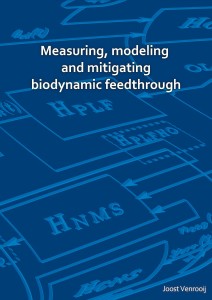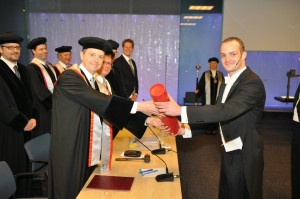Measuring, Modeling and Mitigating Biodynamic Feedthrough
Lead: Joost Venrooij2010-2014 (PhD Project, Completed)
Abstract
This PhD project was completed by Joost Venrooij, when he graduated cum laude in march 2014. The thesis led to 9 journal publications and 9 conference publications. His promotors were professor Heinrich Buelthoff, professor Max Mulder, and David Abbink was co-promotor. Joost received the best Dissertation award of the Max Planck Institute for this thesis in December 2014.

Abstract Vehicle accelerations affect the human body in various ways. In some cases, accelerations cause involuntary motions of limbs like arms and hands. If someone is engaged in a manual control task at the same time, these involuntary limb motions can lead to involuntary control forces and control inputs. This phenomenon is called biodynamic feedthrough (BDFT). The control of many different vehicles is known to be vulnerable to BDFT effects, such as that of helicopters, aircraft, electric wheelchairs and hydraulic excavators.
The fact that BDFT reduces comfort, control performance and safety in a wide variety of vehicles and under many different circumstances has motivated numerous efforts into measuring, modeling and mitigating these effects. Despite the attention that BDFT has received over the last decades, many questions regarding its occurrence remain unanswered. Over the years it has become clear that BDFT is a complex phenomenon in which many different factors play a role. Furthermore, the influence of many of these factors is only poorly understood. It is known that BDFT dynamics depend on vehicle dynamics and control device dynamics, but also on factors such as seating dynamics, disturbance direction, disturbance frequency and the presence of seat belts and arm rests.
The most complex and influential factor in BDFT is the human body. It is through the human body dynamics that the vehicle accelerations are transferred into involuntary limb motions and, consequently, into involuntary control inputs. Human body dynamics vary between persons with different body sizes and weights, but also within one person over time. It is well-known that people adapt their body’s neuromuscular dynamics through muscle co-contraction and modulation of reflexive activity in response to, e.g., task instruction, workload and fatigue. This renders BDFT a variable dynamical relationship, not only varying between different persons (between-subject variability), but also within one person over time (within-subject variability).
The research goal of the work presented in this thesis was to increase the understanding of BDFT to allow for effective and efficient mitigation of the BDFT problem . This thesis deals with several aspects of biodynamic feedthrough, but the work focused on the influence of the variable neuromuscular dynamics on BDFT dynamics . The approach of the research consisted of three parts: first, a method was developed to accurately measure BDFT. Then, several BDFT models were developed that describe the BDFT phenomenon based on various different principles.
Finally, using the insights from the previous steps, a novel approach to BDFT mitigation was proposed.
Status:
Completed
Associated Research Programme:
Supervisors:
Project Output:
- J. Venrooij, M.M. van Paassen, M.Mulder, D.A. Abbink, F.C.T. van der Helm, H.H. Bulthoff. (in press). “A Framework for Biodynamic Feedthrough Analysis-Part II: Validation and Application.” IEEE Transactions on Systems, Man and Cybernetics-Part B
- J. Venrooij, M.M. van Paassen, M.Mulder, D.A. Abbink, F.C.T. van der Helm, H.H. Bulthoff. “A Framework for Biodynamic Feedthrough Analysis-Part I: Theoretical Foundations”. IEEE Transactions on Systems, Man and Cybernetics-Part B
- J. Venrooij, D. A. Abbink, M. Mulder, M. M. van Paassen, M. Mulder, F. C. T. van der Helm, H. H. Bülthoff, “A Biodynamic Feedthrough Model Based on Neuromuscular Principles,” IEEE Trans. Cybernetics, 2013 DOI – <pdf>
- J. Venrooij, M. Mulder, D. A. Abbink, M. M. van Paassen, M. Mulder, F. C. T. van der Helm, H. H. Bülthoff, “Mathematical Biodynamic Feedthrough Model Applied to Rotorcraft,” IEEE Trans. Cybernetics, 2013 DOI – <pdf>
- J. Venrooij, M. D. Pavel, M. Mulder, F. C. T. van der Helm, and H. H. Bülthoff, “A practical biodynamic feedthrough model for helicopters,” CEAS Aeronautical J., vol. 4, no. 4, pp. 421-432, Dec. 2013. DOI – <pdf>
- J. Venrooij, M. Mulder, D. A. Abbink, M. M. van Paassen, F. C. T. van der Helm, H. H. Bülthoff, and M. Mulder, “A New View on Biodynamic Feedthrough Analysis: Unifying the Effects on Forces and Positions.,” IEEE Trans. Cybernetics, vol. 43, no. 1, pp. 129–142, Feb. 2013. DOI – <pdf>
